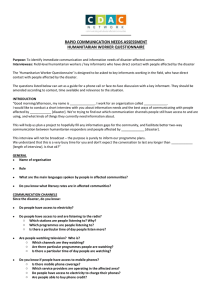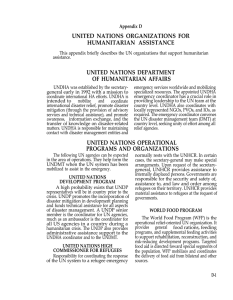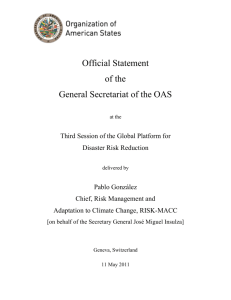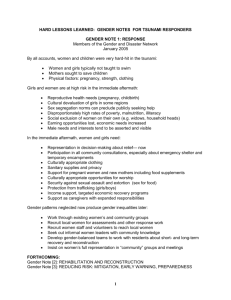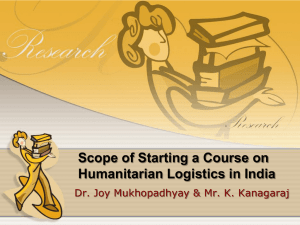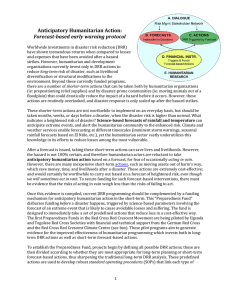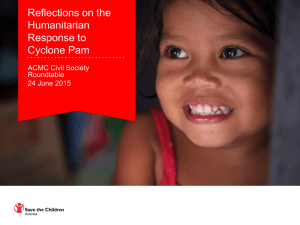2012 JMAT Training Course on Disaster Medicine: Pre
advertisement
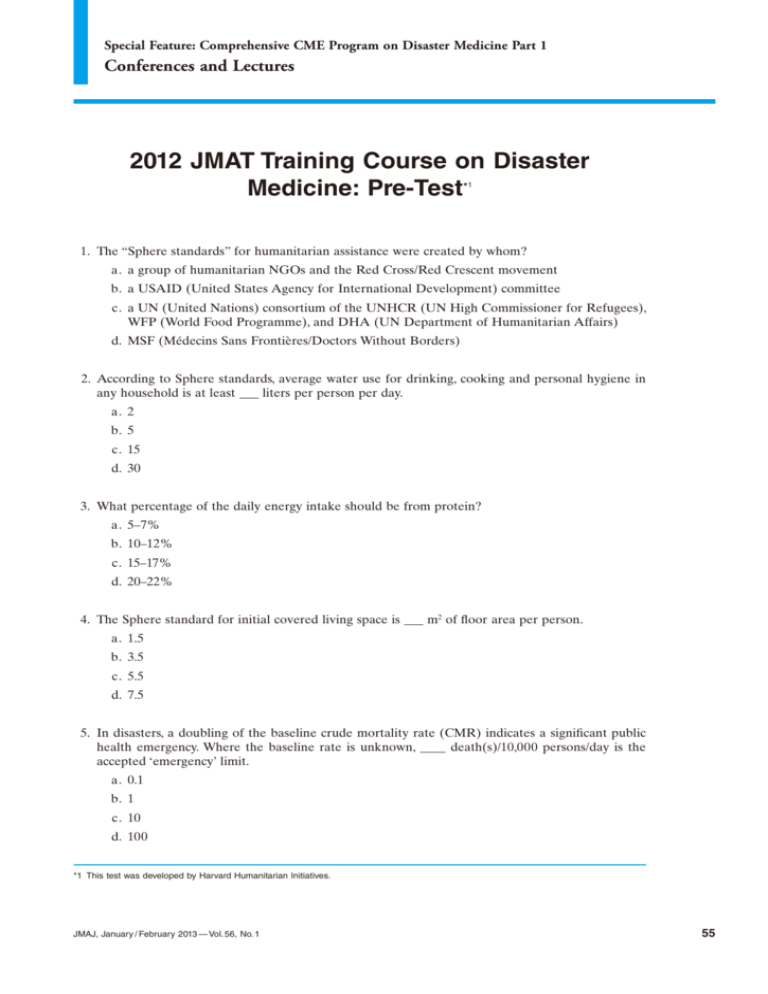
Special Feature: Comprehensive CME Program on Disaster Medicine Part 1 Conferences and Lectures 2012 JMAT Training Course on Disaster Medicine: Pre-Test* 1 1. The “Sphere standards” for humanitarian assistance were created by whom? a. a group of humanitarian NGOs and the Red Cross/Red Crescent movement b. a USAID (United States Agency for International Development) committee c. a UN (United Nations) consortium of the UNHCR (UN High Commissioner for Refugees), WFP (World Food Programme), and DHA (UN Department of Humanitarian Affairs) d. MSF (Médecins Sans Frontières/Doctors Without Borders) 2. According to Sphere standards, average water use for drinking, cooking and personal hygiene in any household is at least liters per person per day. a. 2 b. 5 c. 15 d. 30 3. What percentage of the daily energy intake should be from protein? a. 5–7% b. 10–12% c. 15–17% d. 20–22% 4. The Sphere standard for initial covered living space is m2 of floor area per person. a. 1.5 b. 3.5 c. 5.5 d. 7.5 5. In disasters, a doubling of the baseline crude mortality rate (CMR) indicates a significant public health emergency. Where the baseline rate is unknown, death(s)/10,000 persons/day is the accepted ‘emergency’ limit. a. 0.1 b. 1 c. 10 d. 100 *1 This test was developed by Harvard Humanitarian Initiatives. JMAJ, January / February 2013 — Vol. 56, No. 1 55 Harvard Humanitarian Initiatives 6. You are deployed to a devastated region after a major natural disaster. While addressing any life-threatening needs, your multi-disciplinary team’s first priority should be to: a. complete an initial assessment of needs and resources. b. establish a functional medical clinic for emergency care. c. dig wells or cap springs in areas lacking potable water. d. distribute tents or other appropriate emergency shelter. 7. Soon after an ethnic conflict, you and a coworker come across a set of human remains in the corner of a field. Your next step should be to: a. bring a group of local people to the site to identify the remains. b. bury or cremate the remains according to local customs. c. collect personal effects or clothing for identification and return to the family. d. report your finding to the relevant municipal, religious, or military authority. 8. When should a rapid assessment be performed? a. Only if there is population displacement b. During the first hours of the disaster c. 1 week after the disaster d. 1 month after the disaster 9. How long should a rapid assessment take to complete? a. A few hours to a maximum of 2–3 days b. 1 week c. 2 weeks d. 1 month 10. Which is NOT part of information collected during a rapid assessment? a. Access to food b. Excreta disposal c. Number of unaccompanied minors d. Disease outbreak caused by dead bodies 11. Which is NOT one of the methods of data collection during a rapid assessment? a. Aerial survey b. Transect walk c. Comprehensive population survey d. Key informant interview 56 JMAJ, January / February 2013 — Vol. 56, No. 1 2012 JMAT TRAINING COURSE ON DISASTER MEDICINE: PRE-TEST 12. Which is strongly encouraged in psychological first aid? a. Take time to eat, rest and relax even for short periods so that you can best care for others b. Strongly encourage survivors to talk about their experience c. Tell survivors about other survivor’s experiences d. Strive to work as long as you can until you are too exhausted 13. Which United Nations agency helps the local government to coordinate international disaster response efforts? a. United Nations High Commissioner for Refugees b. World Health Organization c. Office for the Coordination of Humanitarian Affairs d. United Nations Human Settlements Program 14. Which of these is a characteristic of a good humanitarian response leader according to international standards? a. Never shows doubt lest his team question his authority b. Works long hours without a break until the disaster phase is over c. Never seeks feedback from beneficiaries about aid programs d. Makes sure he and his team take breaks and get adequate sleep 15. International standards in humanitarian response require which of the following? a. Responders should be trained in aid delivery b. Beneficiaries should be included in decision-making c. Responders should know and adhere to international standards d. All of the above <Correct Answers> Q1: a Q2: c Q3: b Q4: b Q5: b Q6: a Q7: d Q8: b Q9: a Q10: d Q11: c Q12: a Q13: c Q14: d Q15: d JMAJ, January / February 2013 — Vol. 56, No. 1 57

